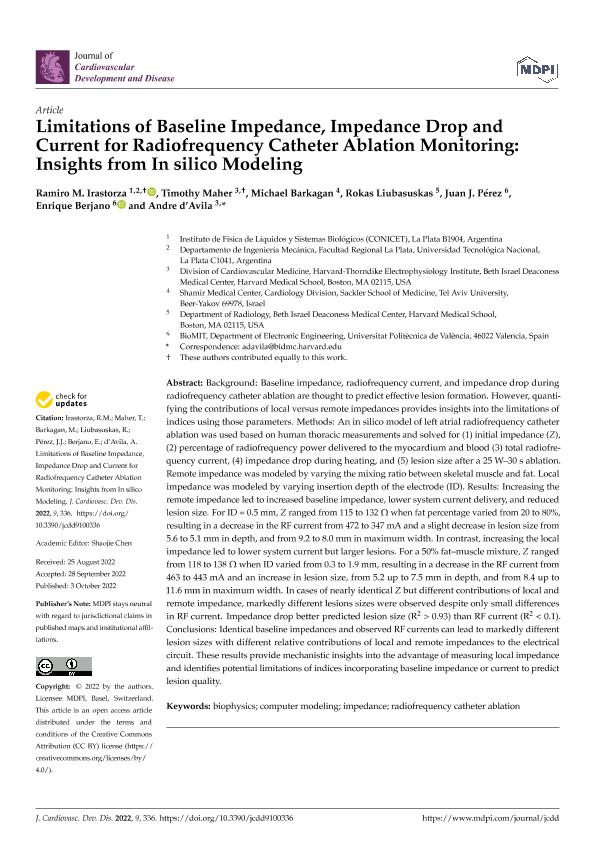Mostrar el registro sencillo del ítem
dc.contributor.author
Irastorza, Ramiro Miguel

dc.contributor.author
Maher, Timothy
dc.contributor.author
Barkagan, Michael
dc.contributor.author
Liubasuskas, Rokas
dc.contributor.author
Pérez, Juan J.
dc.contributor.author
Berjano, Enrique
dc.contributor.author
D’Avila, Andre
dc.date.available
2023-09-22T14:46:42Z
dc.date.issued
2022-10
dc.identifier.citation
Irastorza, Ramiro Miguel; Maher, Timothy; Barkagan, Michael; Liubasuskas, Rokas; Pérez, Juan J.; et al.; Limitations of Baseline Impedance, Impedance Drop and Current for Radiofrequency Catheter Ablation Monitoring: Insights from In silico Modeling; MDPI; Journal of Cardiovascular Development and Disease; 9; 10; 10-2022; 1-12
dc.identifier.issn
2308-3425
dc.identifier.uri
http://hdl.handle.net/11336/212698
dc.description.abstract
Background: Baseline impedance, radiofrequency current, and impedance drop during radiofrequency catheter ablation are thought to predict effective lesion formation. However, quantifying the contributions of local versus remote impedances provides insights into the limitations of indices using those parameters. Methods: An in silico model of left atrial radiofrequency catheter ablation was used based on human thoracic measurements and solved for (1) initial impedance (Z), (2) percentage of radiofrequency power delivered to the myocardium and blood (3) total radiofrequency current, (4) impedance drop during heating, and (5) lesion size after a 25 W–30 s ablation. Remote impedance was modeled by varying the mixing ratio between skeletal muscle and fat. Local impedance was modeled by varying insertion depth of the electrode (ID). Results: Increasing the remote impedance led to increased baseline impedance, lower system current delivery, and reduced lesion size. For ID = 0.5 mm, Z ranged from 115 to 132 Ω when fat percentage varied from 20 to 80%, resulting in a decrease in the RF current from 472 to 347 mA and a slight decrease in lesion size from 5.6 to 5.1 mm in depth, and from 9.2 to 8.0 mm in maximum width. In contrast, increasing the local impedance led to lower system current but larger lesions. For a 50% fat–muscle mixture, Z ranged from 118 to 138 Ω when ID varied from 0.3 to 1.9 mm, resulting in a decrease in the RF current from 463 to 443 mA and an increase in lesion size, from 5.2 up to 7.5 mm in depth, and from 8.4 up to 11.6 mm in maximum width. In cases of nearly identical Z but different contributions of local and remote impedance, markedly different lesions sizes were observed despite only small differences in RF current. Impedance drop better predicted lesion size (R2 > 0.93) than RF current (R2 < 0.1). Conclusions: Identical baseline impedances and observed RF currents can lead to markedly different lesion sizes with different relative contributions of local and remote impedances to the electrical circuit. These results provide mechanistic insights into the advantage of measuring local impedance and identifies potential limitations of indices incorporating baseline impedance or current to predict lesion quality.
dc.format
application/pdf
dc.language.iso
eng
dc.publisher
MDPI
dc.rights
info:eu-repo/semantics/openAccess
dc.rights.uri
https://creativecommons.org/licenses/by/2.5/ar/
dc.subject
BIOPHYSICS
dc.subject
COMPUTER MODELING
dc.subject
IMPEDANCE
dc.subject
RADIOFREQUENCY CATHETER ABLATION
dc.subject.classification
Otras Ingenierías y Tecnologías

dc.subject.classification
Otras Ingenierías y Tecnologías

dc.subject.classification
INGENIERÍAS Y TECNOLOGÍAS

dc.title
Limitations of Baseline Impedance, Impedance Drop and Current for Radiofrequency Catheter Ablation Monitoring: Insights from In silico Modeling
dc.type
info:eu-repo/semantics/article
dc.type
info:ar-repo/semantics/artículo
dc.type
info:eu-repo/semantics/publishedVersion
dc.date.updated
2023-06-29T10:27:12Z
dc.journal.volume
9
dc.journal.number
10
dc.journal.pagination
1-12
dc.journal.pais
Suiza

dc.journal.ciudad
Basel
dc.description.fil
Fil: Irastorza, Ramiro Miguel. Consejo Nacional de Investigaciones Científicas y Técnicas. Centro Científico Tecnológico Conicet - La Plata. Instituto de Física de Líquidos y Sistemas Biológicos. Universidad Nacional de La Plata. Facultad de Ciencias Exactas. Instituto de Física de Líquidos y Sistemas Biológicos; Argentina
dc.description.fil
Fil: Maher, Timothy. Harvard Medical School; Estados Unidos
dc.description.fil
Fil: Barkagan, Michael. Sackler School Of Medicine; Israel
dc.description.fil
Fil: Liubasuskas, Rokas. Harvard Medical School; Estados Unidos
dc.description.fil
Fil: Pérez, Juan J.. Universidad Politécnica de Valencia; España
dc.description.fil
Fil: Berjano, Enrique. Universidad Politécnica de Valencia; España
dc.description.fil
Fil: D’Avila, Andre. Harvard Medical School; Estados Unidos
dc.journal.title
Journal of Cardiovascular Development and Disease
dc.relation.alternativeid
info:eu-repo/semantics/altIdentifier/doi/https://doi.org/10.3390/jcdd9100336
Archivos asociados
